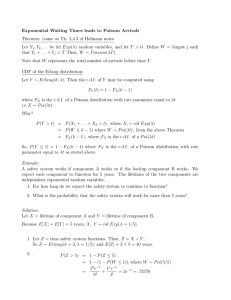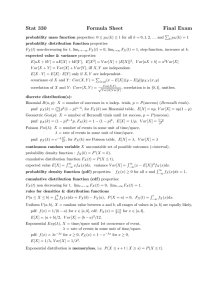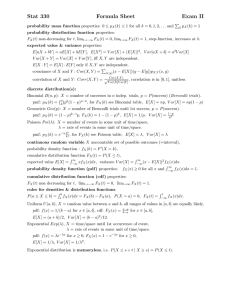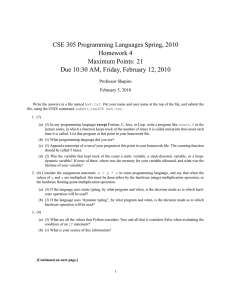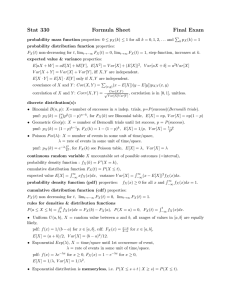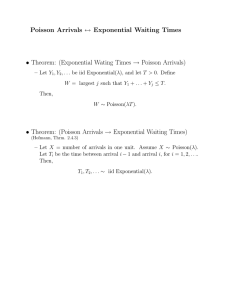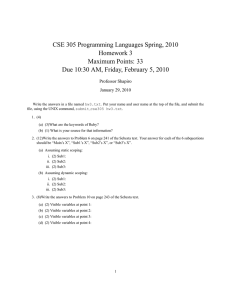Stat 330 Formula Sheet Exam III
advertisement
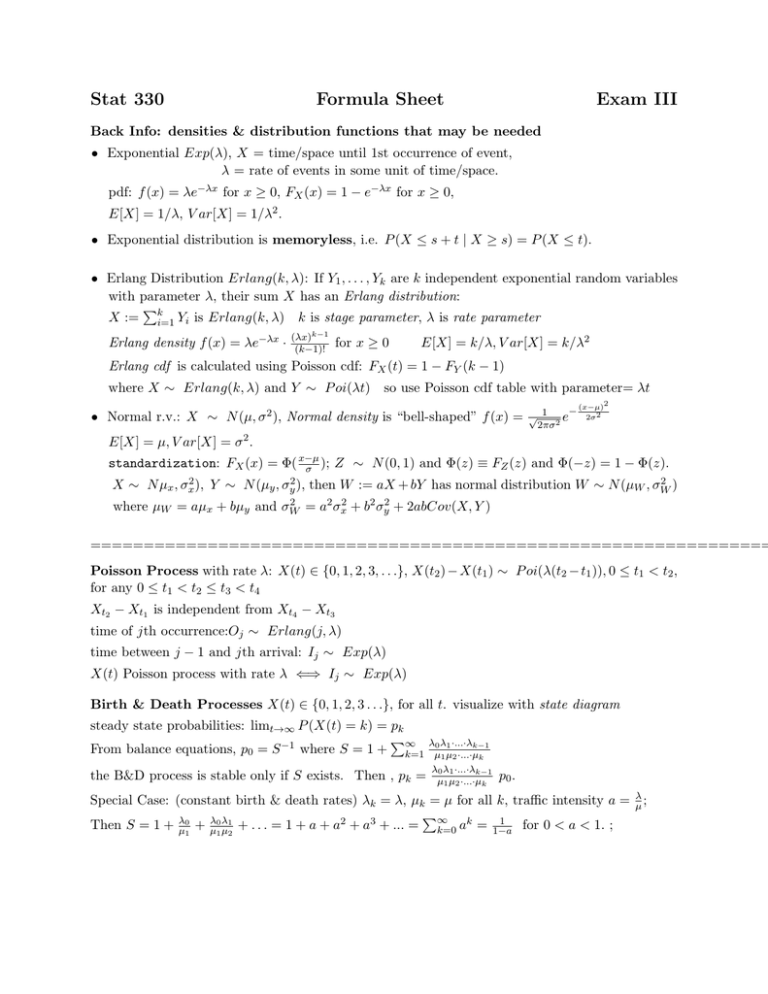
Stat 330
Formula Sheet
Exam III
Back Info: densities & distribution functions that may be needed
• Exponential Exp(λ), X = time/space until 1st occurrence of event,
λ = rate of events in some unit of time/space.
pdf: f (x) = λe−λx for x ≥ 0, FX (x) = 1 − e−λx for x ≥ 0,
E[X] = 1/λ, V ar[X] = 1/λ2 .
• Exponential distribution is memoryless, i.e. P (X ≤ s + t | X ≥ s) = P (X ≤ t).
• Erlang Distribution Erlang(k, λ): If Y1 , . . . , Yk are k independent exponential random variables
with parameter λ, their sum X has an Erlang distribution:
P
X := ki=1 Yi is Erlang(k, λ) k is stage parameter, λ is rate parameter
Erlang density f (x) = λe−λx ·
(λx)k−1
(k−1)!
E[X] = k/λ, V ar[X] = k/λ2
for x ≥ 0
Erlang cdf is calculated using Poisson cdf: FX (t) = 1 − FY (k − 1)
where X ∼ Erlang(k, λ) and Y ∼ P oi(λt)
so use Poisson cdf table with parameter= λt
• Normal r.v.: X ∼ N (µ, σ 2 ), Normal density is “bell-shaped” f (x) =
√ 1 e−
2πσ 2
(x−µ)2
2σ 2
E[X] = µ, V ar[X] = σ 2 .
standardization: FX (x) = Φ( x−µ
σ ); Z ∼ N (0, 1) and Φ(z) ≡ FZ (z) and Φ(−z) = 1 − Φ(z).
2 )
X ∼ N µx , σx2 ), Y ∼ N (µy , σy2 ), then W := aX + bY has normal distribution W ∼ N (µW , σW
2 = a2 σ 2 + b2 σ 2 + 2abCov(X, Y )
where µW = aµx + bµy and σW
y
x
================================================================
Poisson Process with rate λ: X(t) ∈ {0, 1, 2, 3, . . .}, X(t2 ) − X(t1 ) ∼ P oi(λ(t2 − t1 )), 0 ≤ t1 < t2 ,
for any 0 ≤ t1 < t2 ≤ t3 < t4
Xt2 − Xt1 is independent from Xt4 − Xt3
time of jth occurrence:Oj ∼ Erlang(j, λ)
time between j − 1 and jth arrival: Ij ∼ Exp(λ)
X(t) Poisson process with rate λ ⇐⇒ Ij ∼ Exp(λ)
Birth & Death Processes X(t) ∈ {0, 1, 2, 3 . . .}, for all t. visualize with state diagram
steady state probabilities: limt→∞ P (X(t) = k) = pk
P
From balance equations, p0 = S −1 where S = 1 + ∞
k=1
the B&D process is stable only if S exists. Then ,
λ0 λ1 ·...·λk−1
µ1 µ2 ·...·µk
λ0 λ1 ·...·λk−1
pk = µ1 µ2 ·...·µk
p0 .
Special Case: (constant birth & death rates) λk = λ, µk = µ for all k, traffic intensity a = µλ ;
P
1
k
Then S = 1 + µλ01 + µλ01 λµ12 + . . . = 1 + a + a2 + a3 + ... = ∞
k=0 a = 1−a for 0 < a < 1. ;
Markov Chains: Sequence {X(0), X(1), X(2), ...} defined over discrete-time T = {0, 1, 2, ...}.
and discrete-state space {1, 2, 3, ...} . Has Markov property
P {X(t + 1) = j | X(t) = i} = P {X(t + 1) = j | X(t) = i, X(t − 1) = h, X(t − 2) = g, ....
1-step Transition probability pij (t) is defined as pij (t) = P {X(t + 1) = j | X(t) = i}.
(h)
h-step transition probability pij (t) = P (X(t + h) = j | X(t) = i).
Initial distribution P0 is the pmf P0 (x) = P (X(0) = x) for x ∈ {1, 2, , ..., n
Useful results: P (2) = P · P = P 2 ;
P (h) = P h ;
Ph = P0 P h
Steady-state distribution: π = limh→∞ Ph (x), x ∈ X ,
Compute π, i.e. (π1 , π2 , . . . , πn ) by solving the set of equations πP = π,
Regular Markov Chain: if, for some n, all entries of
Pn
P
x πx
= 1.
are positive.
Queues
arrival rate λ, service rate µ
traffic intensity a = µλ , ρ =
a
c
M/M/1 Queue p0 = 1 − a, pk = ak (1 − a), L =
Lq =
a2
1−a ,
L
λa ,
=
1
µ
·
1
1−a ,
Ws = µ1 , Wq =
1 a
µ 1−a ,
P (q(t) ≤ x) = 1 − ae−x(µ−λ) where q(t) is the time spend in the queue
M/M/1/K Queue p0 =
W =
a
1−a , W
1−a
,
1−aK+1
pk = ak p0 , L =
a
1−a
−
(K+1)aK+1
,
1−aK+1
λa = (1 − pK )λ,
Ws = µ1 , Wq = W − Ws , Lq = Wq · λa ,
M/M/c Queue p0 =
P
c
c−1 ak
k=0 k!
a
C(c, a) = p0 c!(1−ρ)
, Lq =
+
ρ
1−ρ C(c, a),
Ws = µ1 , W = Wq + Ws , L = a +
M/M/c/c Queue p0 =
W = Ws , λa = (1 −
ac 1
c! 1−ρ
P
c
ak
k=0 k!
ac
c! p0 )λ,
(
−1
Wq =
, pk =
ak
k! p0
ak
p
c!ck−c 0
for 0 ≤ k ≤ c − 1,
,
for k ≥ c,
1
cµ(1−ρ) C(c, a),
ρ
1−ρ C(c, a)
−1
, pk =
L = W · λa
ak
k! p0 ,
Lq = 0, Wq = 0, Ws = µ1 ,
